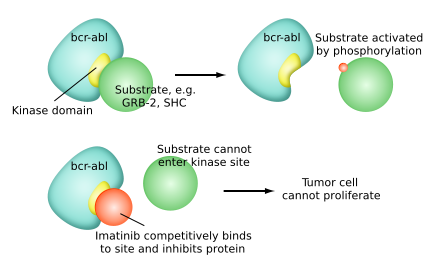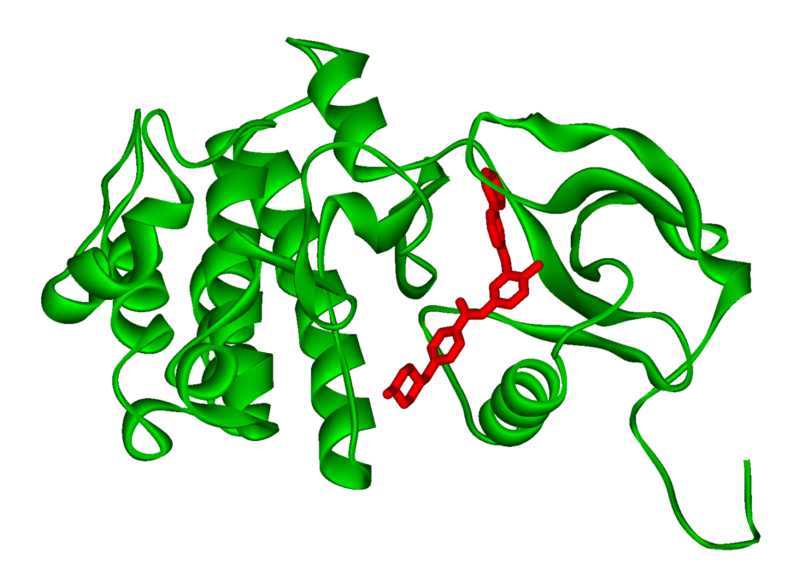Imatinib
 | |
| Clinical data | |
|---|---|
| Pregnancy category | |
| Routes of administration | Oral |
| ATC code | |
| Legal status | |
| Legal status | |
| Pharmacokinetic data | |
| Bioavailability | 98% |
| Protein binding | 95% |
| Metabolism | Hepatic (mainly CYP3A4-mediated) |
| Elimination half-life | 18 hours (imatinib) 40 hours (active metabolite) |
| Excretion | Fecal (68%) and renal (13%) |
| Identifiers | |
| |
| CAS Number |
|
| PubChem CID | |
| DrugBank | |
| E number | {{#property:P628}} |
| ECHA InfoCard | {{#property:P2566}}Lua error in Module:EditAtWikidata at line 36: attempt to index field 'wikibase' (a nil value). |
| Chemical and physical data | |
| Formula | C29H31N7O |
| Molar mass | 493.603 g/mol 589.7 g/mol (mesilate) |
|
WikiDoc Resources for Imatinib |
|
Articles |
|---|
|
Most recent articles on Imatinib |
|
Media |
|
Evidence Based Medicine |
|
Clinical Trials |
|
Ongoing Trials on Imatinib at Clinical Trials.gov Clinical Trials on Imatinib at Google
|
|
Guidelines / Policies / Govt |
|
US National Guidelines Clearinghouse on Imatinib
|
|
Books |
|
News |
|
Commentary |
|
Definitions |
|
Patient Resources / Community |
|
Directions to Hospitals Treating Imatinib Risk calculators and risk factors for Imatinib
|
|
Healthcare Provider Resources |
|
Causes & Risk Factors for Imatinib |
|
Continuing Medical Education (CME) |
|
International |
|
|
|
Business |
|
Experimental / Informatics |
Editor-In-Chief: C. Michael Gibson, M.S., M.D. [2]
Overview
Imatinib is a drug used to treat certain types of cancer. It is currently marketed by Novartis as Gleevec (USA) or Glivec (Europe/Australia) as its mesylate salt, imatinib mesilate (INN). It is occasionally referred to as CGP57148B or STI571 (especially in older publications). It is used in treating chronic myelogenous leukemia (CML), gastrointestinal stromal tumors (GISTs) and a number of other malignancies.
It is the first member of a new class of agents that act by inhibiting particular tyrosine kinase enzymes, instead of non-specifically inhibiting rapidly dividing cells.
Molecular biology
Imatinib is a 2-phenylaminopyrimidine derivative that functions as a specific inhibitor of a number of tyrosine kinase enzymes. It occupies the TK active site, leading to a decrease in activity.
There are a large number of TK enzymes in the body, including the insulin receptor. Imatinib is specific for the TK domain in abl (the Abelson proto-oncogene), c-kit and PDGF-R (platelet-derived growth factor receptor).
In chronic myelogenous leukemia, the Philadelphia chromosome leads to a fusion protein of abl with bcr (breakpoint cluster region), termed bcr-abl. As this is now a continuously active tyrosine kinase, imatinib is used to decrease bcr-abl activity.

The active sites of tyrosine kinases each have a binding site for ATP. The enzymatic activity catalyzed by a tyrosine kinase is the transfer of the terminal phosphate from ATP to tyrosine residues on its substrates, a process known as protein tyrosine phosphorylation. Imatinib works by binding to the ATP binding site of bcr-abl and inhibiting the enzyme activity of the protein competitively. Imatinib is quite selective for bcr-abl – it does also inhibit other targets mentioned above (c-kit and PDGF-R), but no other known tyrosine kinases. Imatinib also inhibits the abl protein of non-cancer cells but cells normally have additional redundant tyrosine kinases which allow them to continue to function even if abl tyrosine kinase is inhibited. Some tumour cells, however, have a dependence on bcr-abl.[1] Inhibition of the bcr-abl tyrosine kinase also stimulates its entry in to the nucleus, where it is unable to perform any of its normal anti-apoptopic functions.[2]
Uses

Imatinib is used in chronic myelogenous leukemia (CML), gastrointestinal stromal tumors (GISTs) and a number of other malignancies. One study demonstrated that Imatinib mesylate was effective in patients with systemic mastocytosis, including those who had the D816V mutation in c-Kit.[3] Experience has shown, however, that imatinib is much less effective in patients with this mutation, and patients with the mutation comprise nearly 90% of cases of mastocytosis. Early clinical trials also show its potential for treatment of hypereosinophilic syndrome and dermatofibrosarcoma protuberans.
In laboratory settings, imatinib is being used as an experimental agent to suppress platelet-derived growth factor (PDGF) by inhibiting its receptor (PDGF-Rβ). One of its effects is delaying atherosclerosis in mice with diabetes.[4]
Recent mouse animal studies at Emory University in Atlanta have suggested that imatinib and related drugs may be useful in treating smallpox, should an outbreak ever occur.[5]
Gleevec is also being used in the treatment of certain brain tumors to include high grade glioblastoma.
Tolerability and side effects

In the United States, the Food and Drug Administration has approved imatinib as first-line treatment for CML.[1] Imatinib has passed through Phase III trials for CML, and has been shown to be more effective than the previous standard treatment of α-interferon and cytarabine. Although the long-term side effects of imatinib have not yet been ascertained, research suggests that it is generally very well tolerated (eg. liver toxicity was much less than predicted). Broadly, side effects such as edema, nausea, rash and musculoskeletal pain are common but mild.
Severe congestive cardiac failure is an uncommon but recognised side effect of imatinib and mice treated with large doses of imatinib show toxic damage to their myocardium.[6]
Metabolism
Metabolism of imatinib occurs in the liver and the main metabolite, N-demethylated piperazine derivative, is also active. The major route of elimination is in the bile, only a small portion is excreted in the urine. Most of imatinib is eliminated as metabolites, only 25% is eliminated unchanged. The half-lives of imatinib and its main metabolite are 18 and 40 hours, respectively.
History
Imatinib was identified in the late 1990s by Novartis chemists. Dr Brian J. Druker led many of the key clinical trials confirming the efficacy of imatinib in CML. Its development is the template for rational drug design. Soon after identification of the bcr-abl target, the search for an inhibitor began. Chemists used a high-throughput screen of chemical libraries to identify the molecule 2-phenylaminopyrimidine. This lead compound was then tested and modified by the introduction of methyl and benzamide groups to give it enhanced binding properties, resulting in imatinib.[7]
Gleevec received FDA approval in May 2001. On the same month it made the cover of TIME magazine as the "magic bullet" to cure cancer.
Gleevec, which costs $32,000 per year for a 400 mg/day dose, is often cited as an example of pharmaceutical industry innovation that justifies the high cost of drugs. Marcia Angell and Arnold S. Relman argue that Gleevec is actually an example of the contribution of taxpayer-supported research and of industry inaction. Novartis patented several tyrosine kinase inhibitors, and lost interest, they write. Drucker tested several, and imatinib was the most potent, and unusually, had almost no effect on normal cells. Novartis had "little corporate enthusiasm," they write, but Drucker persisted[8].
In 2007, imatinib became a test case through which Novartis challenged India's patent laws. This would make it harder for Indian companies to produce generic versions of drugs still manufactured under patent elsewhere in the world. Organisations such as Médecins Sans Frontières argue that a change in law would make it impossible for Indian companies to produce cheap antiretrovirals (anti-AIDS medication), endangering access to these drugs in Third World countries.[9]
References
- ↑ 1.0 1.1 Deininger M, Druker BJ. Specific Targeted Therapy of Chronic Myelogenous Leukemia with Imatinib. Pharmacol Rev 2003;55:401-423. PMID 12869662.
- ↑ Vigneri P, Wang JY. Induction of apoptosis in chronic myelogenous leukemia cells through nuclear entrapment of BCR-ABL tyrosine kinase. Nat Med 2001:7:228-234. PMID 11175855
- ↑ Droogendijk HJ, Kluin-Nelemans HJ, van Doormaal JJ, Oranje AP, van de Loosdrecht AA, van Daele PL. Imatinib mesylate in the treatment of systemic mastocytosis: a phase II trial. Cancer. 2006 Jul 15;107(2):345-51. PMID 16779792
- ↑ Lassila M, Allen TJ, Cao Z, Thallas V, Jandeleit-Dahm KA, Candido R, Cooper ME. Imatinib attenuates diabetes-associated atherosclerosis. Arterioscler Thromb Vasc Biol 2004;24:935-42. PMID 14988091
- ↑ Reeves P, Bommarius B, Lebeis S, McNulty S, Christensen J, Swimm A, Chahroudi A, Chavan R, Feinberg M, Veach D, Bornmann W, Sherman M, Kalman D (2005). Disabling poxvirus pathogenesis by inhibition of Abl-family tyrosine kinases. Nat Med 11 (7): 731-9. PMID 15980865
- ↑ Risto Kerkelä, Luanda Grazette, Rinat Yacobi; et al. "Cardiotoxicity of the cancer therapeutic agent imatinib mesylate". Nature Med. 12: 908&ndash, 16.
- ↑ Druker BJ, Lydon NB. Lessons learned from the development of an Abl tyrosine kinase inhibitor for chronic myelogenous leukemia. J Clin Invest 2000;105:3-7. PMID 10619854
- ↑ [1]How the drug industry distorts medicine and politics: America’s Other Drug Problem, By Arnold S. Relman and Marcia Angell, New Republic, December 16, 2002
- ↑ Médecins Sans Frontières. "As Novartis Challenges India's Patent Law, MSF Warns Access to Medicines Is Under Threat", 2006-09-26. Accessed 2006-02-10.
See also
External link
- Pages with script errors
- CS1 maint: Explicit use of et al.
- CS1 maint: Multiple names: authors list
- E number from Wikidata
- ECHA InfoCard ID from Wikidata
- Articles without EBI source
- Chemical pages without ChemSpiderID
- Articles without KEGG source
- Articles without InChI source
- Articles without UNII source
- Articles containing unverified chemical infoboxes
- Cancer treatments
- Tyrosine kinase inhibitors
- Piperazines